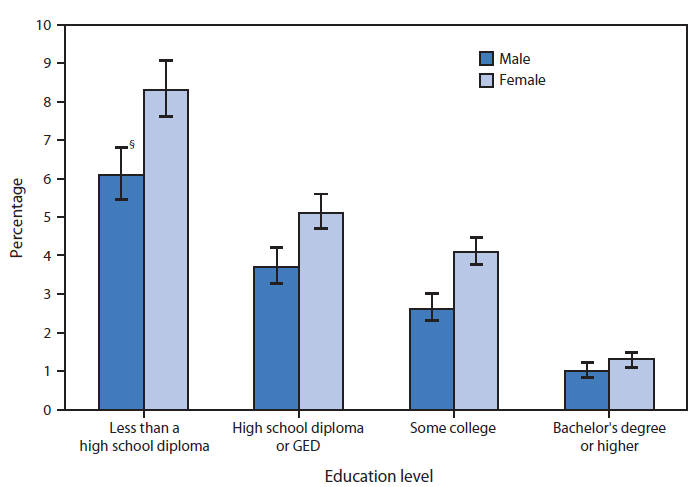QuickStats: Percentage of Adults Aged ≥25 Years with Serious Psychological Distress,* by Education Level and Sex — National Health Interview Survey,† United States, 2010–2013

Abbreviation: GED = general educational development certification.
* Serious psychological distress based on responses to the questions, "During the past 30 days, how often did you feel 1) so sad that nothing could cheer you up, 2) nervous, 3) restless or fidgety, 4) hopeless, 5) that everything was an effort, or 6) worthless?" Response codes for the six items for each person were summed to yield a point value on a 0–24 point scale. A value of 13 or more was used to define serious psychological distress.
† Estimates are based on household interviews of a sample of the noninstitutionalized U.S. civilian population. Estimates are age adjusted using the projected 2000 U.S. population as the standard population and using five age groups: 24–44 years, 45–54 years, 55–64 years, 65–74 years, and ≥75 years.
§ 95% confidence interval.
During 2010–2013, the total age-adjusted percentage of adults aged ≥25 years with serious psychological distress in the past 30 days was 3.5%. As educational attainment increased, the percentage with serious psychological distress decreased among both men and women. Serious psychological distress was six times higher for adults aged ≥25 years with less than a high school diploma (6.1% of men and 8.3% of women), compared with adults with a bachelor's degree or higher (1.0% of men and 1.3% of women). At all education levels, women were more likely than men to experience serious psychological distress.
Source: National Health Interview Survey. Available at http://www.cdc.gov/nchs/nhis.htm.
Reported by: Hashini Khajuria, hwq6@cdc.gov, 301-458-4253; Shilpa Bengeri.
Alternate Text: The figure above is a bar chart showing the percentage of adults aged ≥25 years with serious psychological distress, by education level and sex, in the United States during 2010–2013. During 2010–2013, the total age-adjusted percentage of adults aged ≥25 years with serious psychological distress in the past 30 days was 3.5%. As educational attainment increased, the percentage with serious psychological distress decreased among both men and women. Serious psychological distress was six times higher for adults aged ≥25 years with less than a high school diploma (6.1% for men and 8.3% for women), compared with adults with a bachelor’s degree or higher (1.0% for men and 1.3% for women). At all education levels, women were more likely than men to experience serious psychological distress.
Use of trade names and commercial sources is for identification only and does not imply endorsement by the U.S. Department of
Health and Human Services.
References to non-CDC sites on the Internet are
provided as a service to MMWR readers and do not constitute or imply
endorsement of these organizations or their programs by CDC or the U.S.
Department of Health and Human Services. CDC is not responsible for the content
of pages found at these sites. URL addresses listed in MMWR were current as of
the date of publication.
All MMWR HTML versions of articles are electronic conversions from typeset documents.
This conversion might result in character translation or format errors in the HTML version.
Users are referred to the electronic PDF version (http://www.cdc.gov/mmwr)
and/or the original MMWR paper copy for printable versions of official text, figures, and tables.
An original paper copy of this issue can be obtained from the Superintendent of Documents, U.S.
Government Printing Office (GPO), Washington, DC 20402-9371;
telephone: (202) 512-1800. Contact GPO for current prices.
**Questions or messages regarding errors in formatting should be addressed to
mmwrq@cdc.gov.


